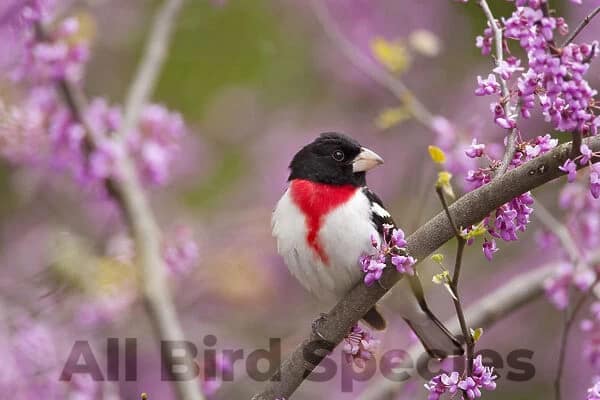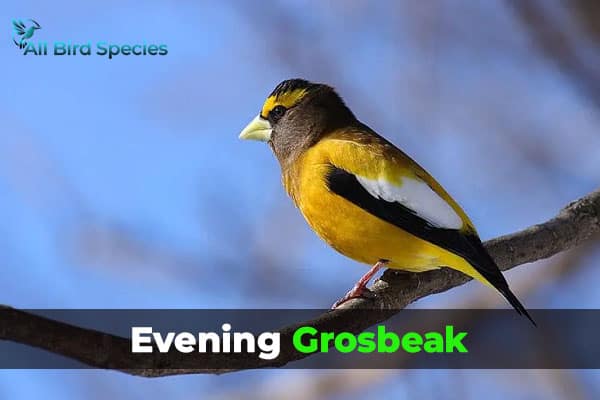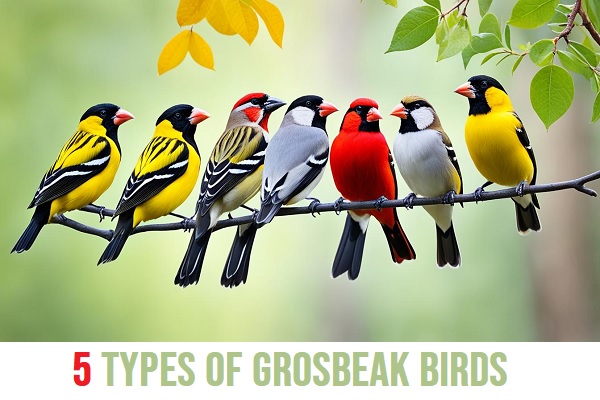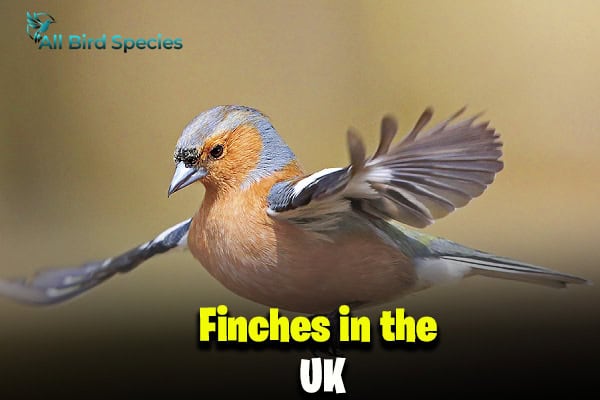5 Types of Grosbeak Birds You Should Know (With Photos)
Have you seen a bird with a big, strong beak for cracking tough seeds? If yes, you met grosbeak birds. These species look amazing and act in interesting ways. Grosbeaks belong to the Cardinalidae family, which means they have big beaks. Their beaks are not just for looks. They help them live in many places, from the South’s field edges to the North and West’s dense forests.birds>
Even though grosbeaks have similar physical features, like their big beaks, they are not closely related. Some are like finches, others like cardinals. Their variety is truly unique. In this article, we’ll examine five amazing grosbeak birds that will catch your eye.
Curious about which grosbeak will amaze you most? Let’s explore and find out!
Rose-breasted Grosbeak (Pheucticus ludovicianus)
The Rose-breasted Grosbeak is a striking bird known for its bold colors. The adult male has a striking red chevron across its throat and breast. Females and juveniles, however, are more subtle. They have streaked brown feathers that help them blend in.
Habitat and Migration Patterns
These birds can be found in deciduous forests and woodland edges in North America. During winter, they migrate to places like Central and South America. Males usually arrive first, followed by the females, to their nesting grounds. This happens from early May in Tennessee to early June in Saskatchewan.

Nesting Habits and Diet
In the breeding season, Rose-breasted Grosbeaks eat seeds, insects, and fruits. Sometimes, they enjoy a little nectar too. Males are often seen cracking open seeds with their big bills. Females look different, with a bold face pattern and a warm buffy wash to the breast.
| Statistic | Value |
|---|---|
| Global Breeding Population | 4.7 million |
| Population Trend (1966-2019) | Slow Decline |
| Conservation Concern Score | 11 out of 20 |
| Nesting Habitat | Saplings, leading to potential population reductions as forests mature |
| Average Lifespan (Wild) | 7.3 years |
| Maximum Lifespan (Captivity) | 24 years |
| Population Trend (1966-present) | >1.5% yearly decline in eastern range, >1.5% yearly increase in western range |
| Migration Patterns | Depart breeding grounds August to mid-late May, return late April to early May |
| Maximum Lifespan (Wild) | 12 years, 11 months |
Black-headed Grosbeak (Pheucticus melanocephalus)
The black-headed grosbeak is famous for its beautiful song and bright colors. The males have a black head, orange chest, and white parts on their wings. Females look more like common sparrows. They live in open woodlands and the edges of forests in the western United States and Mexico. These birds are migratory, moving to Mexico and the southwestern U.S. for winter. They eat seeds, berries, insects, and spiders.
| Appearance | Habitat | Diet | Migration |
|---|---|---|---|
| – Larger and bulkier than a House Finch, more compact and slimmer than an American Robin – Breeding males are rich orange-cinnamon with a black head and black-and-white wings – Females and immature males are brown above with warm orange or buff on the breast, some with streaks on the sides – Flash bright yellow underwings in flight | – Inhabit mixed woodlands and edges from mountain forests to thickets along desert streams to backyards and gardens | – Feed on a variety of seeds, berries, insects, and spiders – Readily visit feeders with sunflower seeds | – Migratory, travel to Mexico and southwestern U.S. for the winter |
Male black-headed grosbeaks don’t get their bright colors until they’re two years old. Young males might look like females or almost like adults. Those that look very close to adult males can own a territory and breed. The oldest known black-headed grosbeak was a male, more than 11 years old. This bird was caught and released in Montana during a research project.
“Black-headed Grosbeaks in central Mexico prey on monarch butterflies, one of the few species of birds that can do so due to toxins in the monarch that make them poisonous to most birds.”
With their amazing songs, beautiful looks, and varied diet, black-headed grosbeaks attract birdwatchers and nature fans in North America’s west.
Evening Grosbeak (Coccothraustes vespertinus)
The evening grosbeak is a strong bird known for its short, thick bill. This bill is great for opening seeds. Males have bright yellow bodies with black and white wings. Females are more subtle, with grayish-yellow colors.
Origins of the Name “Evening Grosbeak”
The bird’s name comes from being seen a lot at dusk. William Cooper, an ornithologist, named them. He called them “Fringilla vespertina,” which means “evening finch” in Latin.

Appearance and Identifying Features
grosbeaks because of their bold colors and big beaks. The males’ yellow bodies and black and white wings stand out. But, females with grayish-yellow shades can often go unnoticed.
Breeding and Irruptive Migration
Evening grosbeaks like nesting in forests or places with lots of bird feeders. They eat various seeds, berries, and bugs. Sometimes, they flock to feeders much farther south than usual in big groups.
Population Decline and Conservation Efforts
Since 1970, evening grosbeak numbers have dropped by 94 percent. This makes them a worry for conservationists. Loss of homes and pesticides might be why they’re decreasing. Efforts to learn and protect these birds are important.
5 Types of Grosbeak Birds
Blue Grosbeak (Passerina caerulea)
Besides the well-known Rose-breasted, Black-headed, and Evening Grosbeaks, you can also spot the Blue Grosbeak and the Pine Grosbeak. The Blue Grosbeak is known for its bright blue color. Males are especially eye-catching, while females have duller, brownish feathers. They live in open woodlands, shrubby places, and farmlands, feeding on insects and various plants.
Pine Grosbeak (Pinicola enucleator)
The Pine Grosbeak is a large finch with a subtle look. Males show a reddish hue, but females and young birds have mainly gray or yellow-green feathers. Known for their big body and strong, conical bills, Pine Grosbeaks are found in boreal forests and areas with many trees. They can be seen in Alaska, Canada, and northern Eurasia, where they eat buds, fruits, and small bugs.

Grosbeak Hybrids and Interbreeding
Grosbeaks have big beaks but not all are closely related. Some grosbeak species do create hybrids where they meet.
In the Great Plains, Rose-breasted and Black-headed Grosbeak hybrids are common. But, in Pennsylvania, a 2020 study found a unique hybrid between a Rose-breasted Grosbeak and a Scarlet Tanager. This surprise mix, seen through DNA, shows how varied grosbeak genetics can be.
Rose-breasted and Black-headed Grosbeak Hybrids
Rose-breasted and black-headed grosbeak hybrids are often found in the Great Plains. They show a mix of features from both parents. This makes them a fascinating find for bird lovers and experts.
Rare Rose-breasted Grosbeak and Scarlet Tanager Hybrid
A special discovery in Pennsylvania in 2020 revealed a Rose-breasted Grosbeak and Scarlet Tanager hybrid. This match, between different bird families, was proven by DNA tests. It shows how versatile grosbeaks and their relatives are in blending their genes.
Attracting Grosbeaks to Backyard Feeders
Grosbeaks are a great sight at bird feeders. To draw them in, use sunflower seeds, both shelled and unshelled. They also like fruit, jelly, and nectar, so adding these foods helps.
Preferred Seeds and Foods for Grosbeaks
Put out black oil sunflower seeds in a proper feeder. This style attracts rose-breasted grosbeaks well. These birds also like other treats such as seeds, suet, fruit, and mealworms. If you want to see northern cardinals and grosbeaks, try safflower seeds.
Feeder Types and Placement
Hopper and tray feeders are a good choice for grosbeak. These birds need easy access to food with their big beaks. Put feeders near trees or shrubs for hiding spots. This makes the area more appealing to grosbeaks.
Grosbeak Songs and Vocalizations
Grosbeaks are famous for their beautiful songs and sounds. These grosbeak songs and grosbeak vocalizations are very important. They help the birds find friends and mark their territory. In areas like eastern and central North America, you can hear the lovely, bird-like song of the rose-breasted grosbeak in the spring and summer. The black-headed grosbeak sings a song that’s much like its cousin, the rose-breasted grosbeak.
Not all grosbeaks sing complex songs, though. For example, the Evening Grosbeak uses simple calls and chirps. Still, their sounds are key for talking to each other and showing who owns what space. Listening to grosbeaks sing and talk makes watching these lively birds even better.

Conservation Challenges for Grosbeaks
Some grosbeak species, like the Blue and Black-headed Grosbeaks, are doing well or even growing in numbers. However, others are not so fortunate. The Evening Grosbeak birds, for instance, has seen its population plummet by 94% since 1970. It is one of the fastest-declining North American songbirds. The cause is not fully clear but might involve losing homes and pesticide use.
The Pine Grosbeak’s numbers have dropped by about half since 1970. This drop is likely due to climate change and forests being cut down in their home. It’s important to keep researching and working hard to protect these birds. Understanding and fighting the threats against the Evening Grosbeak and Pine Grosbeak is key.
Read More Birds Articles
| Woodpecker Spiritual Meaning |
| Vulture Spiritual Meaning |
| Top 10 Types of Ibis |
| American Robin Nests And Eggs |
| Top 7 Brown and White Birds |
Conclusion
Grosbeaks stand out in the bird world with their colorful looks, lovely songs, and interesting actions. Each kind, like the amazing Rose-breasted Grosbeak or the beautiful Blue Grosbeak birds, shows us how varied birds can be. Sadly, some kinds, like the Evening Grosbeak, deal with big conservation challenges.
But, grosbeaks play a big role in nature, which makes them important to protect. By getting to know these birds and helping keep their homes safe, we make sure they stick around. Their beauty and link to the environment deserve our help.
The next time you see a bright Rose-breasted Grosbeak or hear a Black-headed Grosbeak sing, stop and enjoy. These moments remind us of the stunning birds around us. Treasuring their grosbeak beauty and helping keep them safe does a lot for bird life.








